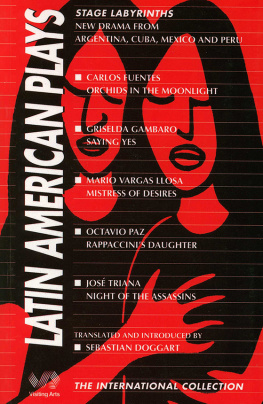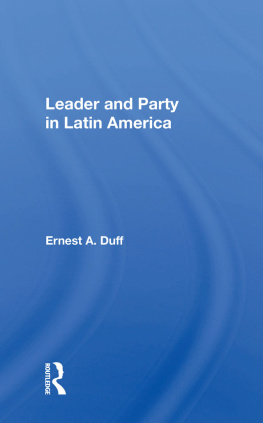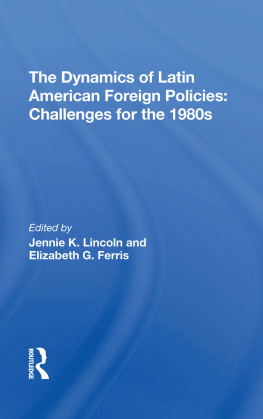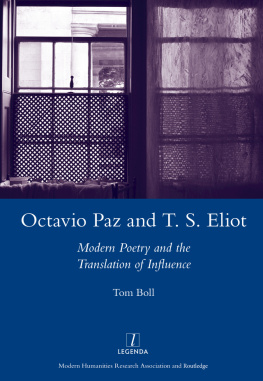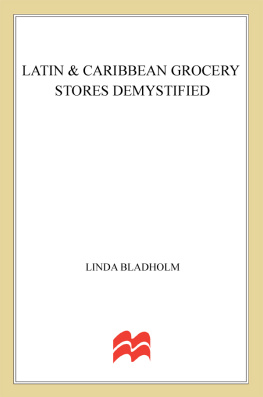Doggart - Latin American Plays New Drama from Argentina, Cuba, Mexico and Peru
Here you can read online Doggart - Latin American Plays New Drama from Argentina, Cuba, Mexico and Peru full text of the book (entire story) in english for free. Download pdf and epub, get meaning, cover and reviews about this ebook. year: 1996, publisher: Nick Hern Books, genre: Art. Description of the work, (preface) as well as reviews are available. Best literature library LitArk.com created for fans of good reading and offers a wide selection of genres:
Romance novel
Science fiction
Adventure
Detective
Science
History
Home and family
Prose
Art
Politics
Computer
Non-fiction
Religion
Business
Children
Humor
Choose a favorite category and find really read worthwhile books. Enjoy immersion in the world of imagination, feel the emotions of the characters or learn something new for yourself, make an fascinating discovery.
Latin American Plays New Drama from Argentina, Cuba, Mexico and Peru: summary, description and annotation
We offer to read an annotation, description, summary or preface (depends on what the author of the book "Latin American Plays New Drama from Argentina, Cuba, Mexico and Peru" wrote himself). If you haven't found the necessary information about the book — write in the comments, we will try to find it.
Doggart: author's other books
Who wrote Latin American Plays New Drama from Argentina, Cuba, Mexico and Peru? Find out the surname, the name of the author of the book and a list of all author's works by series.
Latin American Plays New Drama from Argentina, Cuba, Mexico and Peru — read online for free the complete book (whole text) full work
Below is the text of the book, divided by pages. System saving the place of the last page read, allows you to conveniently read the book "Latin American Plays New Drama from Argentina, Cuba, Mexico and Peru" online for free, without having to search again every time where you left off. Put a bookmark, and you can go to the page where you finished reading at any time.
Font size:
Interval:
Bookmark:

LATIN AMERICAN PLAYS
New Drama from Argentina, Cuba, Mexico and Peru
Rappaccinis Daughter  Octavio Paz
Octavio Paz
Night of the Assassins  Jos Triana
Jos Triana
Saying Yes  Griselda Gambaro
Griselda Gambaro
Orchids in the Moonlight  Carlos Fuentes
Carlos Fuentes
Mistress of Desires  Mario Vargas Llosa
Mario Vargas Llosa
Selected, translated and introduced by
Sebastian Doggart
THE INTERNATIONAL COLLECTION

NICK HERN BOOKS
London
www.nickhernbooks.co.uk
Contents
An Introduction to Latin American Theatre
by Sebastian Doggart
RAPPACCINIS DAUGHTER
by Octavio Paz
NIGHT OF THE ASSASSINS
by Jos Triana
SAYING YES
by Griselda Gambaro
ORCHIDS IN THE MOONLIGHT
by Carlos Fuentes
MISTRESS OF DESIRES
by Mario Vargas Llosa
An Introduction to Latin American Theatre
by Sebastian Doggart
Latin American theatre is an untapped goldmine for the English-speaking world. While the regions novels and poetry are widely read and respected, its theatre remains largely unknown. Few Latin American plays are published or produced in English, and these often suffer from unsympathetic translations. School and university courses mostly ignore Latin American theatre and there is a dearth of critical studies on the subject. The main purpose of this book, therefore, is to encourage the reading, study and staging of Latin American drama.
The book has three sections. First, it presents original translations of five contemporary Latin American plays, which have been prepared in collaboration with the playwrights themselves, and chosen for their high literary and dramatic quality. Although they have specifically Latin American features, they retain qualities that give them a universal accessibility. To test this, all five plays were staged in the UK by English-speaking performers, and these productions have yielded fresh insights into the authors intentions, which have been incorporated into the translations. The plays broad range of styles and subject matter is representative of the rich diversity of drama written since the 1950s. The chosen writers represent four of the most historically vibrant centres of Latin American theatre Cuba, Mexico, Argentina and Peru and their work is concerned with many of the issues and patterns that have preoccupied Latin American dramatists for over five centuries. The second section of the book contains interviews with the playwrights, giving the writers a chance to explain to an English-speaking audience the intentions behind their plays, and to reveal some of their literary and personal sources. The third section is this introduction which contextualises the plays through a historical survey of drama in Cuba, Mexico, Argentina and Peru, and then discusses some of the challenges involved in translating and staging Latin American drama in English.
A Brief History of Latin American Theatre: Pre-1492
Our knowledge of the pre-Columbian period is very limited. Europeans who discovered indigenous spectacles judged them to be primitivelyheretical, banned public performances, and destroyed local records. What information we do have comes from Catholic missionaries, whose reports agreed that throughout the region there was theatre in the form of ritual spectacles, such as Cuban areitos, in which Arawak Indian actors dressed up to enact historical and religious stories using dialogue, music and dance, until they were prohibited by the Spanish colonial administration in 1511. The Aztecs in Mexico used a mixture of dance, music and Nahuatl dialogue to depict the activities of their gods. According to Fray Diego Durn, a Dominican friar, one Aztec festival required a conscripted performer to take on the role of the god Quetzalcotl. As such, he was worshipped for 40 days, after which, to help Huitzilopochtli, god of daylight, fight the forces of darkness, his heart was removed and offered to the moon. His flayed skin was then worn as the gods costume by another performer. While the Incas ruled Peru, the Quechua are reported to have performed ritual spectacles involving dance, costumes and music, but probably not dialogue, to purify the earth, bring fertility to women and the soil, and worship ancestral spirits. The Inca Tupac Yupanqui used his warriors to re-enact his sons victorious defence of the Sacsahuamn fortress above Cuzco against 50,000 invaders.
The only pre-Columbian script to survive the European campaign against indigenous culture, the Rabinal Ach of the Maya-Quich Indians of Central America, is the story of a Quich Warrior who is captured after a long war by his sworn enemy the Rabinal Warrior and, when he refuses to bow down to the Rabinal Warriors king, is sacrificed. The story was told through sung formal challenges, interspersed with music and dance, with each actor wearing an ornate wooden mask which was so heavy that the actors had to be replaced several times during the performance. The last actor playing the Quich warrior was sacrificed. The work was preserved through oral tradition, until 1855 when it was recorded in writing by Charles Brasseur, a French priest in the Guatemalan village of Rabinal. It is still performed there every January omitting the final sacrifice.
1492-1550
The arrival of the Spaniards led to a blending, or mestizaje, of local and European influences, which has since become one of the most distinctive features of Latin American theatre. Catholic missionaries identified the theatre as an effective tool for converting the local people to Christianity, and in Mexico, the Franciscans sought to transform the religious beliefs of the Aztecs by learning Nahuatl and studying their rituals and ceremonies. In doing so, they found that Aztec and Christian religions had much in common: the Aztecs associated the cross with Quetzalcoatl, baptised newly-born children, confessed to the godswhen they transgressed, and practised communion through the eating of human sacrifices. The Franciscans dramatised such symbols and rituals in the local language, so that the Aztecs would become more open to conversion through identification with the characters.
Theatrical presentations were usually staged in open chapels, built on the site of indigenous places of worship, with wooden platforms resembling end-on stages. Mass preceded performances, which were based on local dance and song, and celebrated European religious and secular authority. In the early 1500s, the Church turned to a more effective technique for storytelling and evangelising: a modified version of the Spanish auto sacramental, a one-act religious allegory which was performed on feast days, especially Corpus Christi. Such Indo-Hispanic autos are the first theatrical works to be described legitimately as plays, in that they were formally scripted. The Catholic missions also put on large-scale productions for mass conversions and to foster new communities revolving around the Church. One of the most spectacular of these events was the Franciscan production of the
Font size:
Interval:
Bookmark:
Similar books «Latin American Plays New Drama from Argentina, Cuba, Mexico and Peru»
Look at similar books to Latin American Plays New Drama from Argentina, Cuba, Mexico and Peru. We have selected literature similar in name and meaning in the hope of providing readers with more options to find new, interesting, not yet read works.
Discussion, reviews of the book Latin American Plays New Drama from Argentina, Cuba, Mexico and Peru and just readers' own opinions. Leave your comments, write what you think about the work, its meaning or the main characters. Specify what exactly you liked and what you didn't like, and why you think so.

